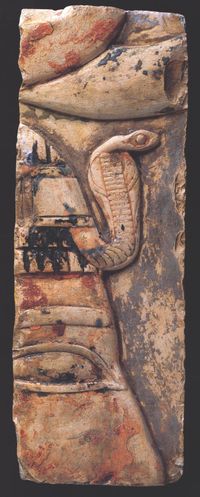
Relief fragments from procession of attendants
An item at Metropolitan Museum of Art
Neferu was most likely the first queen and perhaps also sister of Nebhepetre Mentuhotep II. Her plundered tomb, excavated by the Metropolitan Museum of Art between 1923 and 1931, lay outside the king's temple precinct at Deir el Bahri. It was visited as a shrine in the Eighteenth Dynasty, and at some point it was used as a quarry for the fine limestone covering the walls. The carving of Neferu’s surviving reliefs is varied in quality, with the finest example being a succession of female bearers (see 26.3.353g). The extenuated proportions of the figures, and the elaborate patterns contrasting with smooth planes, represent the height of the Eleventh Dynasty archaic style. The background was left unpainted, while the figures were either detailed or covered with orange, pink, purple, blue, green, white or black paint. This group of relief fragments is in raised relief, which predominated on the walls of the long passage leading from the entrance toward the inner chamber. The figures of attendants preserved in here approached representations of the queen from right and left, some carrying sun shades. For other reliefs from the tomb of Neferu, see 31.3.1 and 26.3.353*.
Egyptian Art
An exhibit at Metropolitan Museum of Art
The Met collection of ancient Egyptian art consists of approximately 30,000 objects of artistic, historical, and cultural importance, dating from about 300,000 BCE to the 4th century CE. A signifcant percentage of the collection is derived from the Museum's three decades of archaeological work in Egypt, initiated in 1906 in response to increasing interest in the culture of ancient Egypt.




